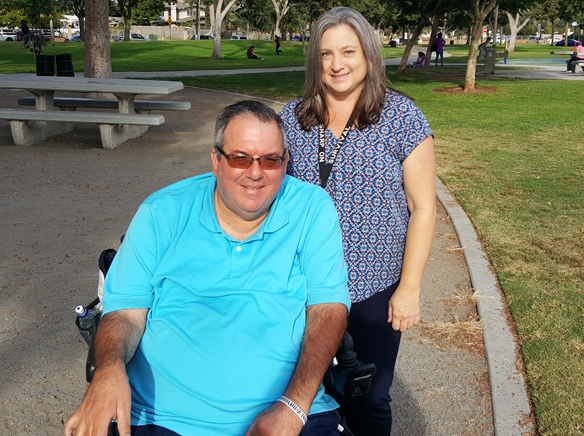When Tim Boice was in high school, his vision for the future included pitching for a major league baseball team. Being confined to a wheelchair was not a thought until he suffered a debilitating spinal injury; now it is his only option. But Tim uses his story and his life to teach others.
“Use your mind, affect your body,” Tim says, adding that for a disabling injury, “prevention is the only cure. I’m preaching prevention.”
When Tim Boice was in high school, his vision for the future included pitching for a major league baseball team. Being confined to a wheelchair was not a thought until he suffered a debilitating spinal injury; now it is his only option. But Tim uses his story and his life to teach others.
“Use your mind, affect your body,” Tim says, adding that for a disabling injury, “prevention is the only cure. I’m preaching prevention.”
Tim is one of the amazing people who work for Sharp on Survival, a mostly grant-funded project to educate youth about saving lives through injury and violence prevention.
It is a topic few stop to think about and even fewer care to. The sad fact is that every two seconds, someone sustains a disabling injury; every six minutes, someone dies from a preventable injury. In California alone, eight youth die and over 100 are hospitalized from traumatic injuries daily. Youth under the age of 24 years are most at risk. Practicing simple safety habits can prevent over 90% of these unintentional injuries.
Shelly Atkinson is a community health educator and a recreation therapist. She coordinates the program for the Sharp healthcare organization. Tim is one of three workers and, with over 15 years of experience with the group, is their lead VIP (Voices for Injury Prevention). The program began to address diving injuries many years ago, with “Feet First, First Time.” It was associated with an international organization called Think First, created to prevent brain and spinal injuries sustained by diving into shallow waters. The program has evolved to include more common types of youth injury. The main goal is to visit schools and places to educate children, teens and youth about how the small choices they make can have lifelong consequences.
It’s not surprising that our youth are at risk for injury. Who hasn’t suffered a skinned knee or broken bone in their childhood? Kids are active. They ride skateboards and bicycles, play sports and jump into water. The key is to teach kids how to do all of these activities safely, to “use your mind to protect your body.” Injuries often occur when it seems kids are doing the right thing, like wearing a helmet. But if the helmet is not attached correctly, then it offers no protection. Unprotected sports are another problem – the need for the right gear worn the right way. One of the most common risks (and one of the easiest to prevent) is injury from being unrestrained in a car or truck – riding in the back seat without a seatbelt. If we teach our kids and train them to do the safe thing, we can prevent unintentional injury. Sounds like Parenting 101, doesn’t it? But these lessons can sometimes be neglected in our busy and harried day-to-day life. Unfortunately, the consequences of such failure will have a lifelong impact.
So Shelly and her crew get into the community to get the word out. They talk to preschoolers and high school students. They speak from experience. In a way, it is show-and-tell, as the students can’t miss Tim’s wheelchair or the special van he drives.
It’s not your usual youth healthcare subject because, “it’s not a happy topic,” Shelly points out.
Tim said, “You encourage prevention because these injuries don’t go away. Family and friends are affected. Certainly finances are affected.”
“Most of these types of injuries I see in the hospital are preventative,” Shelly said.
Tim was injured in 1981. Some years later he was asked by Grossmont Hospital to speak to a Boy Scout troop as part of the “Feet First, First Time” program. “Next to death, (public) speaking was my greatest fear.” But then he realized that all he had to do was talk about himself and he felt anyone could do that. So he addressed those 100 boys, and many more since, and he discovered something within himself. “It became something I was passionate about. I knew I had an ability to share and talk to people and get a message across.
“My focus is not only prevention but disability awareness. Over the years we’ve seen people grow up with more understanding about diversity and disability awareness and tolerance. The kids of our generation kind of, I use the words ‘Get it.’ They understand that we are more like each other that we are different. It’s a real shame when a parent has to grab their kids and say ‘don’t stare,’ rather than approach someone who might look a little different and ask if it’s OK if we ask what happened.
“I always tell people if they don’t want to be asked ‘what happened,’ maybe they should stay home.”
One of the things that makes Tim’s day is when he is recognized from a prior presentation. “Those are my ‘rock star’ moments, when someone from the community recognizes me from, say, 10 years ago.” In fact, recently the team was presenting at Grossmont High School and one of the teachers remembered Tim from her days as a student at Monte Vista High.
“It kind of just hits you out of nowhere that some of what you say does stick with people,” Shelly commented, “We know we’re not going to reach everybody. We can tell which students in the room ones are going to walk away with something and which ones are not. But for those who do listen, it’s impactful.”
And that’s the difference with this program, as Shelly pointed out that while she could talk about what she sees as a clinician in the hospital, it doesn’t mean anything without someone there to share their personal testimony and experience.
“We call them our VIP’s – Voices for Injury Prevention – and without them sharing their story and how their lives have changed, or how a choice they made or someone else made impacted them, we would be far less effective.
“And they also are a voice for inspiration and motivation. It’s amazing the things that have come out of (our presentations). We’ve had students come up in tears to say thank you. One student said they had hurt their leg last year and haven’t been able to skateboard since. They’d been down and depressed and angry about it. But after listening to Tim, they realized they really had nothing to be angry about – that it could have been so much worse for them. This student felt foolish that they let their emotions get out of control when they looked at someone (like the VIP) who has a really good attitude.”
“We do see results in the community,” Tim said, “We do see good things happening. I saw a kid crash on his bike on the Silver Strand. My niece and I went over to help him up and I said, ‘Oh my gosh” – he was wearing one of our Think First helmets that he got a health fair.”
Interestingly, the current three-man team of VIP’s is all Aztec alumni (of different ages) and all injured in the same manner: each was an unrestrained passenger in the back seat of a car. All were about the same age when they sustained their injuries. This type of injury is extremely prevalent but rarely heard of in the media. It just isn’t news. Yet, one of the most dangerous things our kids do daily is get into a car.
This is not a “scared straight” program or one about doom and gloom. Rather, it is firsthand knowledge of how the choices you make will affect you for life, and how a little prevention will go a long way. You just have to use your head and think about it.
Sharp on Survival is a grant-funded program. If you are interested in accessing, scheduling, or participating in the program, call Shelly Atkinson at (858) 939-4416 or visit the Sharp website at www.sharp.com.














